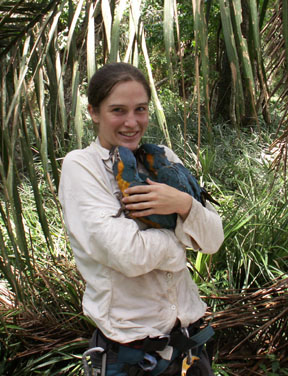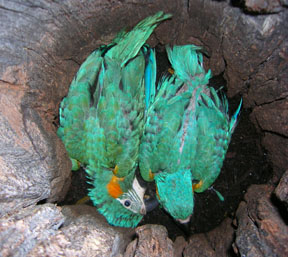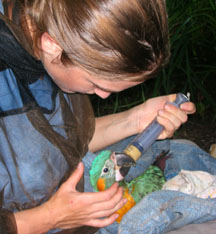I finally meet Goliath and Manu, 2 beautiful Barba Azul (Blue-throated Macaw) chicks who I will be looking out for.
November 17th - The big Barba Azul chicks of Isla 2, named Manu and Goliath, are so beautiful! Today was my first time to see large Barba Azul chicks, all feathered out and looking like actual parrots. They are so different from the tiny, two-week-old Isla Grande chick (near the estancia 10 km away), which looks like an empanada with wings. Manu and Goliath are about 2 months old, (Goliath is slightly older) and this leaves them with about one more month in the nest before they should fledge. I don't think anyone in the history of this project has been able to see a Barba Azul chick fledge...it is my biggest hope that I might witness this amazing event.
In the afternoon Sarah D. and I hiked to the island, Vaca Muerta to check out the activity of a pair of BTMs who have been hanging around their nest cavity since their first attempt failed due to flooding in August. I climbed the tree and looked into the nest cavity-there, on the woodchips of the cavity floor was a macaw egg! Thrilled and with high hopes, Sarah and I hid ourselves about 50 meters from the nest, and waited to see who the parents of this egg might be. Shortly, a pair of white-eyed conures (Aratinga leucopthalmus) came by and one perched at the cavity entrance. We watched with curiosity as the conure peered inside the cavity. I knew the egg wasn't theirs-it was far too big-but I didn't know if the conures would have enough interest in the cavity to pose a risk to the potential BTM (Blue-throated Macaw) egg. Luckily, the conures seemed content to look only and did not enter the cavity. We waited and waited, wondering "where could they be?" and finally, at 5:15 pm a pair of Barba Azul flew in. One of them landed at the nest cavity and looked in. Sarah and I snuck off the island, leaving the couple to their parenting work in their improved, flood-proof nest hole.
25 November 2007
I have been here for ten days now, on this little forest island, where myself and one other volunteer are charged with the care of two Blue-throated Macaw nests. Our two nests are at opposite ends of the spectrum in their timing-the Isla 2 nest has Goliath and Manu, who will fledge in about a month, while the Vaca Muerta nest has three newly laid eggs. If all goes well, these eggs should hatch around the same time as Goliath and Manu leave their nest. The Vaca Muerta nest is so named because it is located on an island that was discovered with a freshly dead cow (vaca muerta = dead cow). Vaca Muerta is a half-hour walk from our camp at Isla Chiquita, while the Isla 2 nest is only a 5 minute walk, on an adjoining island.
Our work consists mainly of morning and afternoon shifts, watching the nest cavities from blinds, to ensure that these valuable nests are not predated, and to watch for unusual behavior in the adults that might indicate a problem. The Vaca Muerta nest is actually a second attempt by this pair, after their first clutch of eggs failed due to flooding in August. Now that they've re-laid and are incubating, San Pedro, the patron saint of rain and bad weather, is beginning to show his strength. The newly added drain holes, drilled through the bottom of the cavity after the August flood, will certainly be put to the test. As of this evening, the female is in her nest, incubating, while San Pedro tips it down all around her.
I had hoped that being flooded out of my tent while completely isolated from any "civilized" comforts would be an experience unique to my previous work with the Blue-fronted Parrots in Argentina, but clearly this is not to be. I will move my tent to higher ground and use the machete to dig canals around the border, since we don't have a shovel. The water is soaking through my thermarest pad right now, as I sit here writing, and I don't know how much luck I will have trying to sleep on it tonight. Perhaps I would be better off in the hammock...if it would stop raining. Well, at least it's not cold. Being wet for one night is nothing but a slight annoyance as long as I'm warm enough. I am more worried about the parrot chicks than I am about my sleeping arrangements. Poor Goliath and Manu...I hope they're not too wet. I hope their parents are keeping their crops nice and full. I am more worried than usual about these two chicks because Goliath has gotten very thin in the past few weeks, and because when I did the evening shift at their nest today their parents did not make an appearance. Tomorrow we will climb the tree to check on them and if Goliath has not gained weight we will start to give supplemental feedings.
This little camp is certainly an amazing place for wildlife viewing. I almost tripped over a Tamadua today (a small, arboreal anteater) while walking through the tall grass next to the island, and I recently found out that the strange cow-like grunting noises I often hear at night actually might be jaguars! Other permanent residents to Isla Chiquita (aside from ourselves) are an armadillo named Changuito, an arboreal porcupine called Puerquito, a pair of aplomado falcons named Ruben and Madidi, and a troop of black howler monkeys that roam through the treetops between Isla Chiquita and Isla 2.



































